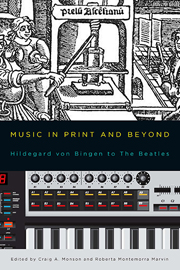Book contents
- Frontmatter
- Dedication
- Contents
- Acknowledgments
- Introduction
- 1 Robert Granjon and Music during the Golden Age of Typography
- 2 Publishing Music Theory in Early Cinquecento Venice and Bologna: Friends and Foes
- 3 Preaching to the Choir: Arts of Persuasion in the Converts of Italy
- 4 Music Distribution in London during Handel's Lifetime: Manuscript Copies versus Prints
- 5 Beethoven's Miniatures
- 6 “The Beautiful and the Ugly”: Travel Literature, Racial Theory, and a Schumann Song
- 7 Verdi's “Music of the Future”
- 8 The Suspended Voice of Amália Rodrigues
- 9 More than Mostly Mozart: Teddy Wilson's “China Boy”
- 10 Wanted Dead and Alive: Historical Performance Practice and Electro-Acoustic Music from IRCAM to Abbey Road
- 11 Lowinsky's Secrets
- 12 The Unknown Hildegard: Editing, Performance, and Reception (An Ordo Virtutum in Five Acts)
- List of Contributors
- Index
2 - Publishing Music Theory in Early Cinquecento Venice and Bologna: Friends and Foes
Published online by Cambridge University Press: 05 March 2014
- Frontmatter
- Dedication
- Contents
- Acknowledgments
- Introduction
- 1 Robert Granjon and Music during the Golden Age of Typography
- 2 Publishing Music Theory in Early Cinquecento Venice and Bologna: Friends and Foes
- 3 Preaching to the Choir: Arts of Persuasion in the Converts of Italy
- 4 Music Distribution in London during Handel's Lifetime: Manuscript Copies versus Prints
- 5 Beethoven's Miniatures
- 6 “The Beautiful and the Ugly”: Travel Literature, Racial Theory, and a Schumann Song
- 7 Verdi's “Music of the Future”
- 8 The Suspended Voice of Amália Rodrigues
- 9 More than Mostly Mozart: Teddy Wilson's “China Boy”
- 10 Wanted Dead and Alive: Historical Performance Practice and Electro-Acoustic Music from IRCAM to Abbey Road
- 11 Lowinsky's Secrets
- 12 The Unknown Hildegard: Editing, Performance, and Reception (An Ordo Virtutum in Five Acts)
- List of Contributors
- Index
Summary
“Regarding the Diffinitorio by Tinctoris that you say you have, I don't care, because the copy I have is sufficient. And what you say about the retratatione of this Diffinitorio is news to me.” Thus wrote the Bolognese music theorist Giovanni Spataro to the Venetian musician Marc'Antonio Cavazzoni on August 1, 1517, in answer to a lost letter. This is the earliest known reference to the printing of Johannes Tinctoris's Terminorum musicae diffinitorium, which appeared without name of printer or place of publication, but on typographical evidence is believed to come from the press of Gerardus de Lisa in Treviso circa 1495. Considering the date of Cavazzoni's letter and Spataro's reaction, the incunabulum was not well known at the time, although thirteen copies survive today. It may seem surprising to us that Spataro was not interested in obtaining the printed edition of Tinctoris's dictionary, even if it was a revised edition, but I suspect that he did not find the Diffinitorium very interesting, since it did not discuss problems of music theory. In fact, it annoyed him, as we see from another of his letters, in which he took umbrage at Tinctoris's definition of color. “Tinctoris was crazy, and thought he knew a lot more than he did, as his works demonstrate.”
Printing music theory meant that books could be widely disseminated, and, as I will show elsewhere, led to the first book reviews, amply attested in the Spataro Correspondence.
- Type
- Chapter
- Information
- Music in Print and BeyondHildegard von Bingen to The Beatles, pp. 36 - 61Publisher: Boydell & BrewerPrint publication year: 2013

